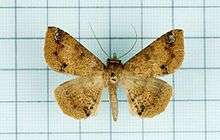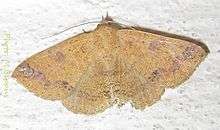Ericeia inangulata
Ericeia inangulata, the sober tabby, is a moth in the family Erebidae. The species was first described by Achille Guenée in 1852. It is found in the Indo-Australian tropics of China, India, Sri Lanka, Myanmar, and the Marianas and Carolines, Fiji, Vanuatu, New Caledonia and Samoa.[3]
| Sober tabby | |
|---|---|
 | |
 | |
| Scientific classification | |
| Kingdom: | Animalia |
| Phylum: | Arthropoda |
| Class: | Insecta |
| Order: | Lepidoptera |
| Superfamily: | Noctuoidea |
| Family: | Erebidae |
| Genus: | Ericeia |
| Species: | E. inangulata |
| Binomial name | |
| Ericeia inangulata | |
| Synonyms | |
| |
Description
The wingspan is 47–48 mm.[4] Adults are sexually dimorphic and highly variable in color. Palpi with longer third joint. Hindlegs of male tufted with long hair to the extremity of the tarsi. Mid tibia of male with large masses of flocculent hair contained in a fold. Body purplish grey, ochreous, reddish or fuscous brown with more or less irrorated with fuscous. Forewings with sub-basal, antemedial, medial, postmedial and sub-marginal indistinct sinuous dark lines. The minute orbicular and large reniform spots are indistinct. There is an almost marginal dark specks series. These markings may be obsolete or fairly prominent. Each line may be double and consist of disjoined striga or lunules. The area inside the sub-marginal and medial lines is fuscous suffused, or ferrous. Some forms have elongate or prominent reniform. A grey apical patch and a dark spot on sub-marginal line above inner margin found in ochreous forms. Hindwings with indistinct medial line with crenulate line beyond it. A waved submarginal line and almost marginal dark specks series can be seen.[5]
Young instars whitish, but later instars become blackish. Full-grown larvae rest along sticks or twigs. Pupation takes place in a slight cocoon of silk amongst litter on the ground. They crawl in looping movements.[6]
The larvae feed on various plants, including Acacia mearnsii, Scutia myrtina, Cassia fistula, Cassia javanica, Albizia, Cassia, Dalbergia, Mimosa, Paraserianthes, Senna, Xylia, Adiantum, Lagerstroemia and Citrus species.[7]
Subspecies
- Ericeia inangulata inangulata
- Ericeia inangulata levuensis (Prout, 1929) (Fiji, Vanuatu, New Caledonia and Samoa)
References
- Savela, Markku. "Ericeia inangulata (Guenée, 1852)". Lepidoptera and Some Other Life Forms. Retrieved January 15, 2019.
- Yu, Dicky Sick Ki. "Ericeia inangulata (Guenee)". Home of Ichneumonoidea. Taxapad. Archived from the original on January 15, 2019. Retrieved January 15, 2019.
- Holloway, Jeremy Daniel. "Ericeia inangulata Guenée". The Moths of Borneo. Retrieved October 4, 2019.
- "中南夜蛾 Ericeia inangulata (Guenee, 1852)". 驚奇山行 [Surprise mountain line]. January 10, 2011. Retrieved January 15, 2019.
- Hampson, G. F. (1894). The Fauna of British India, Including Ceylon and Burma: Moths Volume II. Taylor and Francis – via Biodiversity Heritage Library.
- Herbison-Evans, Don & Crossley, Stella (May 18, 2018). "Ericeia inangulata (Guenée, 1852) Sober Tabby". Australian Caterpillars and their Butterflies and Moths. Retrieved 15 January 2019.
- "Sober Tabby - Ericeia inangulata (Guenée, 1852)". African Moths.